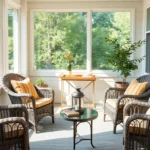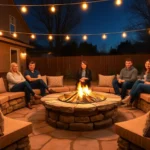We believe everyone deserves a beautiful garden regardless of their space limitations. Whether you’re dealing with a tiny balcony apartment or a compact backyard, creating a stunning outdoor oasis isn’t just possible—it’s incredibly rewarding.
Small spaces actually offer unique advantages that many gardeners overlook. They’re easier to maintain, more budget-friendly, and allow you to experiment with creative design answers that simply wouldn’t work in larger areas. You can achieve maximum impact with minimal effort when you know the right techniques.
We’ve discovered that the most successful small gardens aren’t about cramming everything into a tiny space—they’re about smart planning and strategic choices. From vertical growing techniques to multi-functional plant selections, there are countless ways to transform even the smallest outdoor area into your personal green sanctuary. Let’s explore how you can maximize every square inch of your space.
Vertical Garden Solutions for Limited Space
Vertical gardening transforms unused wall space into productive growing areas while preserving precious ground space. We’ll explore three effective vertical answers that maximize your garden’s potential without expanding its footprint.
Living Walls and Trellises
Living walls create stunning focal points that transform blank surfaces into thriving green spaces. We recommend starting with modular pocket planters or felt wall systems that accommodate herbs like basil, oregano, and thyme alongside compact flowering plants such as pansies and marigolds.
Trellises support climbing vegetables including peas, beans, and cucumbers while adding vertical structure to your design. Wooden lattice panels work well for lightweight plants, while metal grid systems handle heavier climbers like grape vines and climbing roses.
Wall-mounted planter boxes offer another effective solution for growing shallow-rooted crops. We suggest installing these at varying heights to create visual interest while providing easy access for watering and harvesting.
Hanging Planters and Suspended Gardens
Hanging baskets use overhead space to grow trailing plants like cherry tomatoes, strawberries, and cascading flowers. We position these containers at different heights to create layered growing zones that don’t compete for ground space.
Macrame plant hangers add bohemian charm while supporting lightweight pots filled with succulents, air plants, or small herbs. These work particularly well in covered patios where they’re protected from strong winds.
Ceiling-mounted pulley systems allow us to raise and lower heavy planters for easy maintenance. This solution works best for larger containers growing substantial plants like dwarf fruit trees or large flowering specimens.
Tiered Planting Systems
Ladder planters create multiple growing levels using repurposed wooden ladders or purpose-built tiered stands. We place larger plants on bottom rungs and smaller specimens higher up to ensure proper light distribution.
Stacked container gardens use different-sized pots arranged in pyramid formations. This method works well for growing different varieties of the same plant, such as various lettuce types or herb collections.
Step-style raised beds built against walls or fences provide graduated planting areas that maximize growing space. We design these with the tallest plants in back graduating to shorter ones in front for optimal sun exposure.
Container Gardening Ideas for Small Spaces
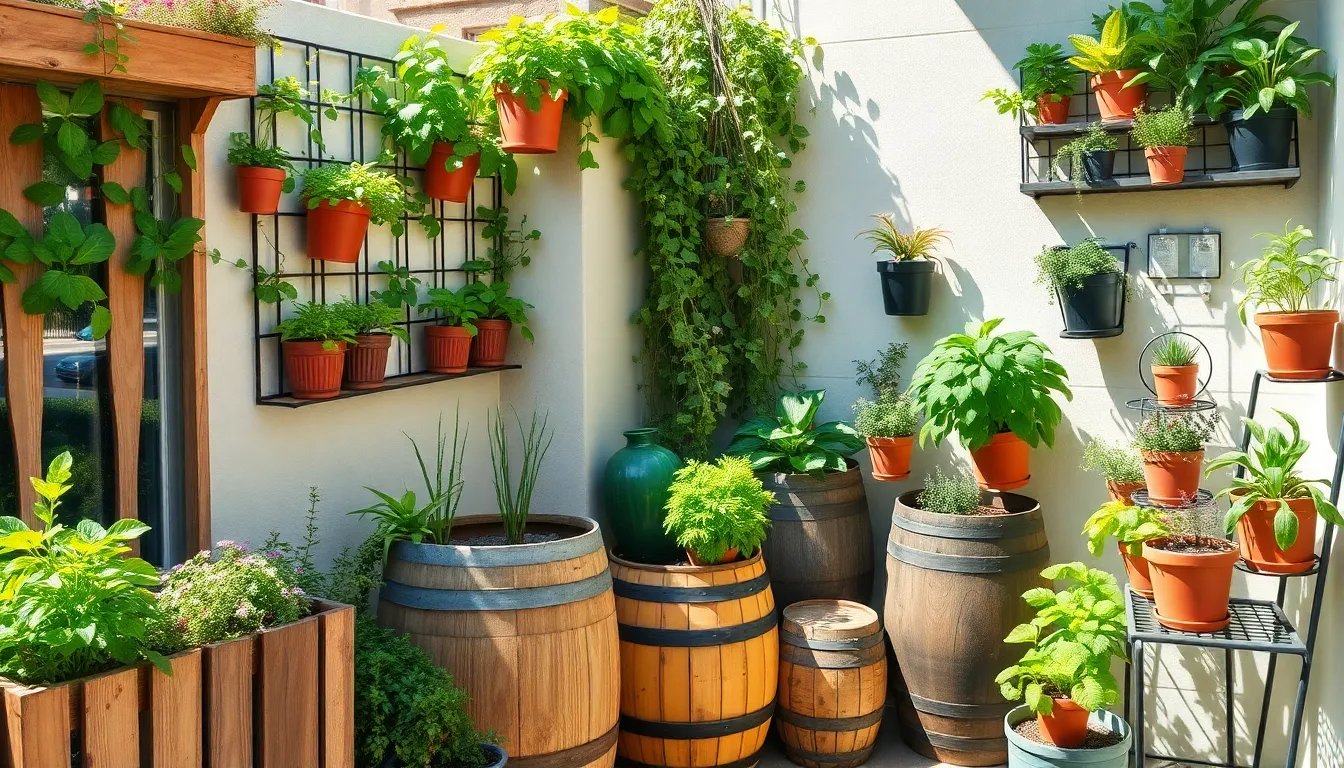
Container gardening transforms any small space into a productive growing area using pots, buckets, or creative vessels. We can arrange containers vertically on shelves or use hanging planters to maximize our available space while creating visual interest through different sizes, shapes, and colors.
Raised Bed Alternatives
Tabletop planters offer elevated growing surfaces without requiring permanent installation or extensive materials. We recommend these portable answers for renters or those who need flexibility in their garden layout.
Fabric grow bags provide excellent root aeration and drainage while taking up minimal storage space when not in use. These lightweight containers work perfectly for urban environments where traditional raised beds aren’t practical.
Vertical wall gardens use unused wall space to create multiple planting levels. We can install these systems on fences, exterior walls, or balcony railings to grow herbs and compact vegetables efficiently.
Window Box Gardens
Windowsill installations bring fresh herbs and flowers directly to our kitchen windows for easy harvesting. We attach these classic containers to windowsills, railings, or exterior walls using sturdy brackets.
Shallow root plant selection ensures success in window box environments. We choose herbs like basil and oregano, compact vegetables such as lettuce and radishes, plus annual flowers that thrive in confined spaces.
Proper drainage systems prevent waterlogging in window boxes mounted against buildings. We drill adequate drainage holes and use quality potting mix to maintain healthy root systems.
Repurposed Container Options
Wooden crates and vintage barrels create rustic charm while providing ample growing space for larger plants. We ensure these containers have proper drainage holes before adding soil and plants.
Everyday household items like tin cans, plastic tubs, and old boots become unique planters with character. We transform these budget friendly materials into functional garden features that add personality to our small spaces.
Creative vessel selection turns any waterproof container into a potential planter. We use items such as colanders for excellent drainage, galvanized buckets for modern appeal, and ceramic bowls for indoor herb gardens.
Space-Saving Plant Selection Strategies
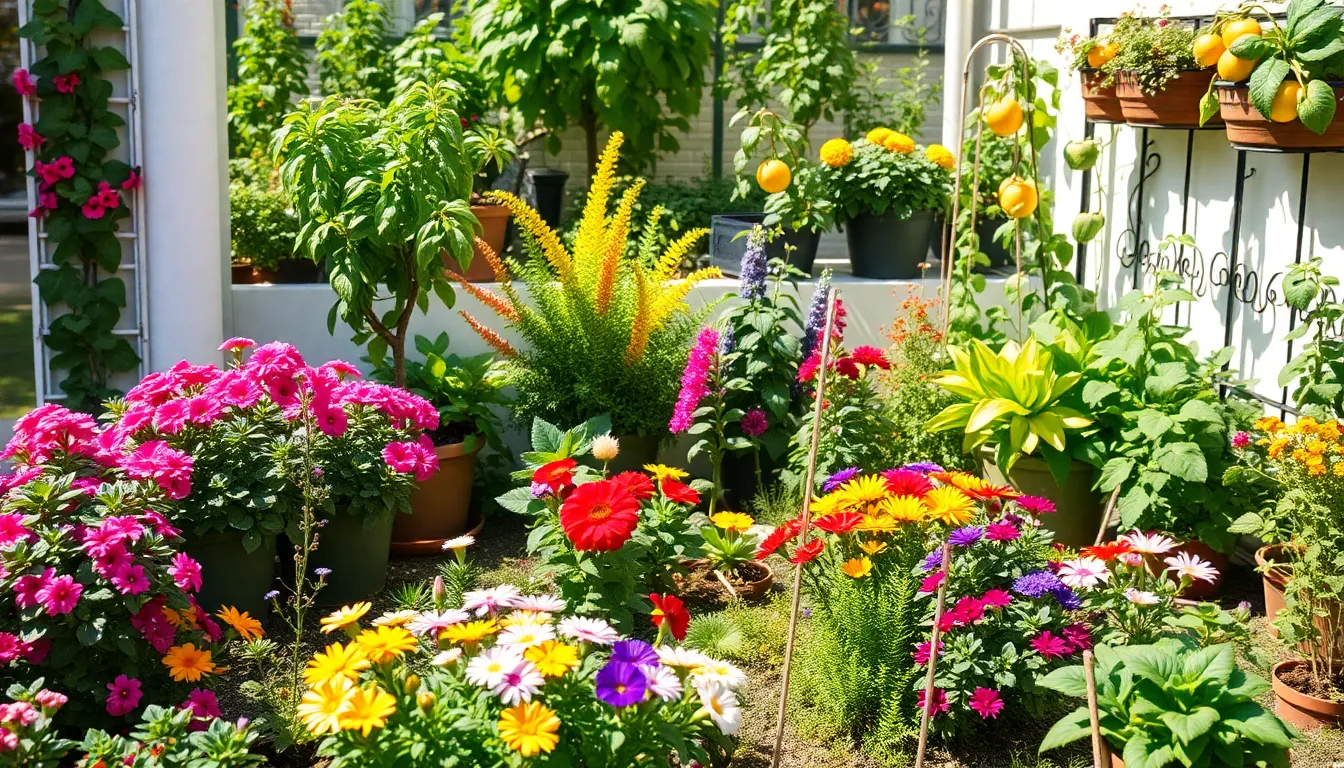
Smart plant choices form the foundation of any successful small garden design. We’ll explore three key strategies that maximize your growing potential while working within space constraints.
Dwarf and Compact Varieties
Dwarf varieties deliver full-sized beauty in miniature packages, making them perfect for small garden spaces. Compact shrubs like boxwood or dwarf spiraea provide year-round structure without overwhelming your garden’s footprint. Small fruit trees such as dwarf apple or cherry varieties offer the same delicious harvests as their full-sized counterparts while requiring 75% less space.
Miniature cultivars of popular perennials give you maximum visual impact in minimal square footage. Consider dwarf hostas for shaded areas or compact lavender varieties that stay under 18 inches tall. These plants grow slower than standard varieties, allowing you to fit more diversity into your space without creating overcrowding issues.
Climbing dwarf roses or compact clematis varieties can grow vertically on trellises, freeing up valuable ground space for other plantings. This vertical approach lets you enjoy climbing beauty without sacrificing precious horizontal growing area.
Multi-Purpose Edible Plants
Edible plants that double as ornamental features maximize both beauty and productivity in small spaces. Herbs like rosemary, thyme, and lavender provide culinary ingredients while offering attractive foliage and fragrant blooms throughout the growing season. These versatile plants serve as natural borders or focal points while supplying fresh seasonings for your kitchen.
Berry bushes such as blueberries or compact raspberry varieties combine delicious harvests with attractive seasonal interest. Dwarf fruit trees like figs or citrus varieties in containers provide shade, beauty, and fresh fruit from the same footprint.
Vertical supports transform edible climbers like peas, beans, or cucumbers into living screens that save ground space. These plants grow upward on trellises or arbors, creating privacy while producing fresh vegetables. This approach lets you enjoy homegrown produce without dedicating separate areas for purely ornamental plants.
Fast-Growing Options for Quick Results
Fast-growing plants provide immediate impact when you need quick results to fill gaps or create focal points. Quick-growing climbers such as wisteria, clematis, or ornamental ivy can cover walls and fences within a single growing season, softening hard boundaries and making your garden feel larger.
Annual flowers like marigolds, zinnias, or nasturtiums deliver vibrant color bursts without permanent space commitments. These plants establish quickly from seed and provide continuous blooms throughout the growing season, letting you experiment with different color schemes each year.
Fast-growing perennials like daylilies or ornamental grasses establish rapidly and return stronger each season. These plants help you achieve mature garden looks without waiting years for slow-growing varieties to reach full size, giving you immediate satisfaction from your small garden investment.
Creative Layout Designs for Tiny Gardens

We’ll explore strategic layout approaches that transform cramped outdoor spaces into organized, productive growing areas. Smart design principles maximize every square inch while creating visual appeal.
Square Foot Gardening Method
Square foot gardening divides planting beds into organized 1-foot sections that enable intensive planting with minimal resources. This systematic approach proves highly effective for small gardens because it maximizes yield while minimizing waste. Each individual square hosts a exact number of plants based on their mature size, creating better organization and easier maintenance access.
We recommend starting with a 4×4 foot raised bed divided into 16 squares for beginners. Large plants like tomatoes occupy one full square, while medium plants like lettuce fit four per square. Small plants such as radishes or carrots can accommodate 16 plants per section. This method eliminates the guesswork from spacing and prevents overcrowding that often plagues traditional row gardening.
Circular and Curved Garden Beds
Circular and curved garden beds create natural flow that counteracts the rigid boundaries common in small spaces. These organic shapes guide our eyes around the garden, making tight areas feel significantly larger by eliminating sharp corners and boxy appearances.
Curved beds allow creative planting arrangements with better access from multiple sides. We suggest using a garden hose to outline curved shapes before digging, ensuring smooth flowing lines. Round beds work particularly well as focal points in square yards, while serpentine borders soften harsh fence lines. The curved design also enables graduated planting heights, with taller specimens in the center tapering to shorter plants at the edges.
Corner and Edge Utilization
Corner and edge spaces offer untapped potential for expanding growing areas without sacrificing central garden access. Installing trellises in corners supports climbing plants that provide vertical greenery while making spaces feel less enclosed and more open.
We maximize corner utility by creating triangular planting beds that fit snugly into 90-degree angles. These spaces work perfectly for compact fruit trees or tall ornamental grasses that add height without spreading horizontally. Garden edges benefit from low-growing shrubs or ornamental grasses that provide year-round structure and visual interest.
Strategic edge planting includes narrow borders along fences or walkways using plants like boxwood or lavender. These linear plantings define spaces while keeping pathways clear for movement and maintenance access.
Multi-Functional Garden Features

Smart garden features that serve multiple purposes transform our small spaces into highly functional outdoor sanctuaries. We can maximize every square inch by choosing elements that combine practicality with beauty.
Seating with Built-In Planters
Garden benches with integrated planters create comfortable spots to relax while surrounding us with fresh blooms and herbs. These dual-purpose features position planters at the sides or beneath bench seats for immediate access to our favorite plants. We’ll find these designs particularly effective in keyhole garden layouts where seating becomes the central focal point. Built-in planter seating works exceptionally well along garden perimeters, creating natural boundaries while providing essential storage for soil and gardening tools underneath the seats.
Storage Answers That Double as Garden Elements
Hidden storage compartments built into garden benches keep our tools organized without consuming additional floor space. Weather-resistant shelves and cabinets serve as both storage units and display platforms for our potted plant collections. We can install raised planters with storage underneath to house soil bags, fertilizers, and seasonal decorations. These answers eliminate the need for separate storage sheds while maintaining easy access to everything we need for garden maintenance. Vertical storage towers work particularly well in corners, providing multiple shelves for supplies while supporting climbing plants on their exterior surfaces.
Water Features in Compact Designs
Tabletop fountains bring the soothing sound of water to our gardens without requiring permanent installation or extensive plumbing. We can position shallow bird baths as central focal points in keyhole gardens or along perimeter edges to attract wildlife. Wall-mounted water features maximize our growing space by utilizing vertical surfaces instead of valuable ground area. Hanging water elements work beautifully on pergolas or fence structures, creating visual interest while conserving floor space for other garden activities. These compact designs typically require minimal maintenance while providing the tranquil atmosphere that makes small gardens feel like peaceful retreats.
Indoor Small Garden Ideas
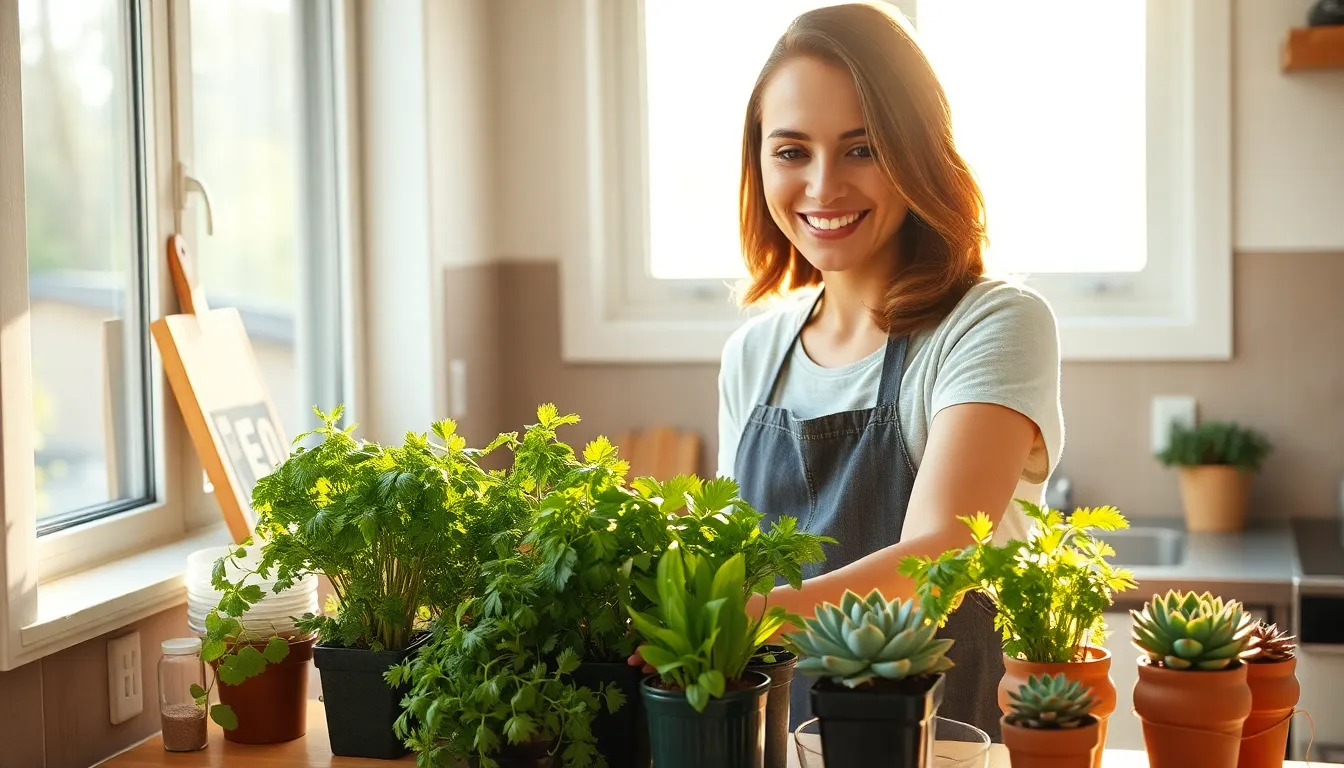
Moving our gardening efforts indoors opens up year-round growing possibilities that don’t depend on outdoor weather or space limitations.
Herb Gardens on Kitchen Counters
Kitchen counter herb gardens bring fresh flavors within arm’s reach while we cook our favorite meals. Basil, parsley, cilantro, and thyme thrive exceptionally well in small pots or containers placed directly on countertops near windows. These aromatic plants require only moderate sunlight and regular watering to flourish in our indoor spaces. Growing herbs on kitchen counters eliminates trips to the grocery store for expensive packaged herbs while ensuring we always have fresh ingredients available. Popular varieties like rosemary and oregano also adapt beautifully to counter growing, providing us with a continuous harvest throughout the seasons.
Succulent Arrangements for Low Maintenance
Succulent gardens offer the perfect solution for busy gardeners who want beautiful plants without demanding care routines. These resilient plants require minimal water and thrive with neglect, making them ideal choices for our indoor growing spaces. Their compact sizes and diverse shapes create stunning visual arrangements in small pots, terrariums, or decorative containers. Varieties like jade plants, echeveria, and string of pearls flourish in bright, indirect light without frequent watering sessions. Arranging different succulent types together creates ever-changing displays that add natural beauty to any room while requiring virtually no maintenance from us.
Hydroponic Systems for Year-Round Growing
Hydroponic growing systems revolutionize indoor gardening by eliminating soil and using nutrient-rich water answers instead. These innovative setups enable us to cultivate herbs, leafy greens, and certain vegetables throughout the entire year regardless of outdoor conditions. Water usage drops significantly compared to traditional soil gardening while plants grow faster and produce higher yields in controlled environments. Basic hydroponic configurations require containers, water, nutrients, plant anchors, and light sources, often supplemented with artificial lighting for optimal growth.
Lettuce, herbs, and leafy greens perform exceptionally well in year-round hydroponic systems, while summer crops like strawberries and tomatoes also thrive with appropriate equipment. Ebb and flow systems adapt perfectly to seasonal changes by periodically flooding roots with nutrient answers, balancing moisture and oxygen levels efficiently. These customizable and cost-effective systems transform small indoor spaces into productive growing areas that deliver fresh produce regardless of weather or season limitations.
Budget-Friendly Small Garden Solutions
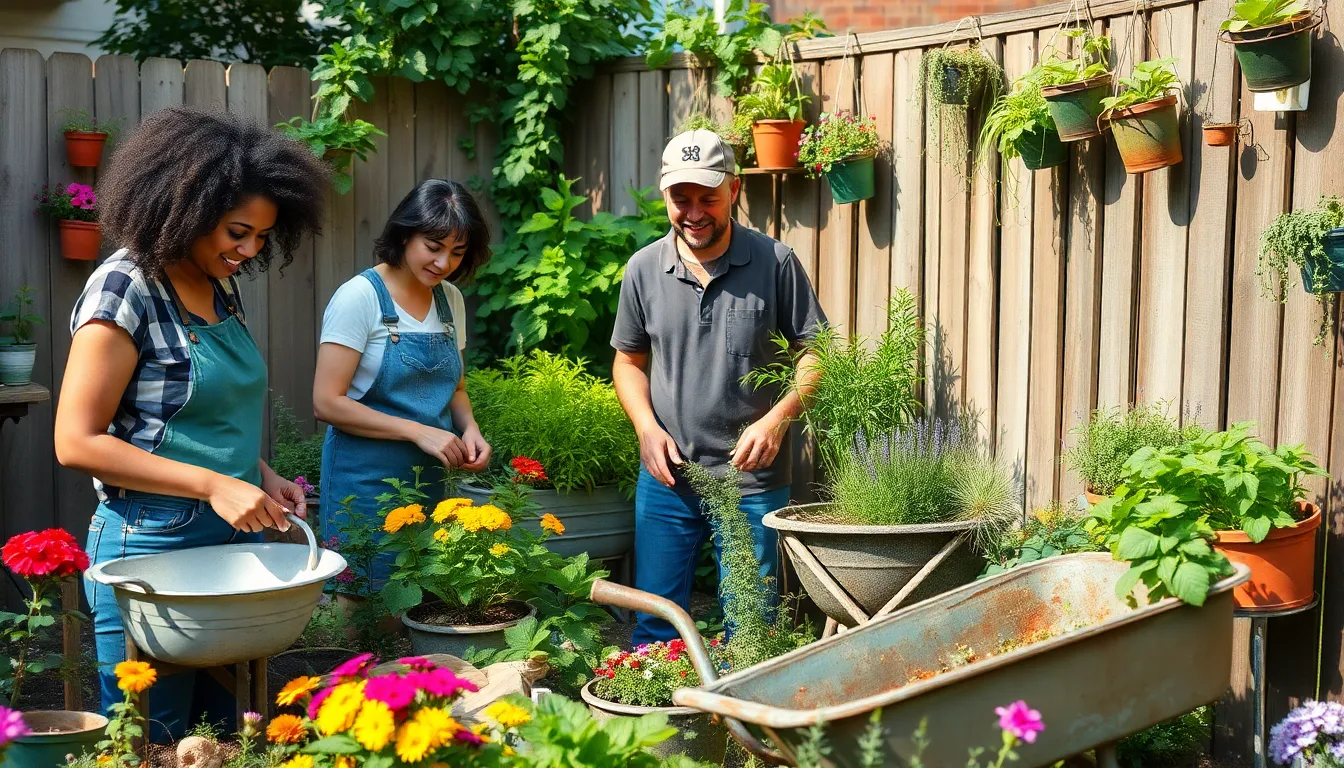
Creating a beautiful small garden doesn’t require a large budget when we use smart, cost-effective strategies. Strategic planning and resourceful approaches can transform limited spaces into thriving gardens without very costly.
DIY Projects Using Recycled Materials
Old wheelbarrows become charming portable planters with simple drainage hole modifications, allowing us to move our gardens as seasons change. We can mount gutters along fences or walls to create space-saving herb gardens that maximize vertical growing areas. Colanders make excellent ready-made planters since their existing holes provide perfect drainage for herbs and flowers.
Simple paint applications transform these repurposed colanders into colorful garden accents that complement our outdoor décor. Pallets and industry fabric combine to create affordable vertical gardens that use unused wall space effectively. Sun catchers crafted from recycled glass and mosaic stepping stones made from broken pottery add artistic flair to our garden pathways without expensive materials.
Seed Starting vs. Buying Plants
Starting seeds offers important cost savings compared to purchasing mature plants while providing access to wider plant variety selections. We gain more control over growing conditions and can time our plantings precisely for optimal garden performance. Seed starting requires more time investment and careful attention during germination and early growth phases.
Buying mature plants delivers instant garden impact and works perfectly when we need immediate results or lack adequate space for seed starting setups. Mature plants reduce the risk of growing failures and provide guaranteed garden establishment. We balance our approach by starting easy seeds like herbs and lettuce while purchasing challenging plants like tomatoes and peppers.
Tool Sharing and Space Optimization
Neighborhood tool sharing programs reduce individual equipment costs while building community connections among fellow gardeners. We organize tool libraries or informal sharing arrangements to access expensive items like tillers and pressure washers without storage concerns.
Posts elevate our pot displays to create multi-level growing areas that maximize vertical space utilization. Stepping stones provide easier access through dense plantings while protecting soil from compaction damage. Tiered planter arrangements stack containers at different heights to ensure all plants receive adequate sunlight exposure.
Hanging planters and wall-mounted systems use previously unused fence and wall areas for additional growing space. We install shelving units along sunny walls to display multiple container plants in organized, accessible arrangements.
Seasonal Adaptation for Small Gardens
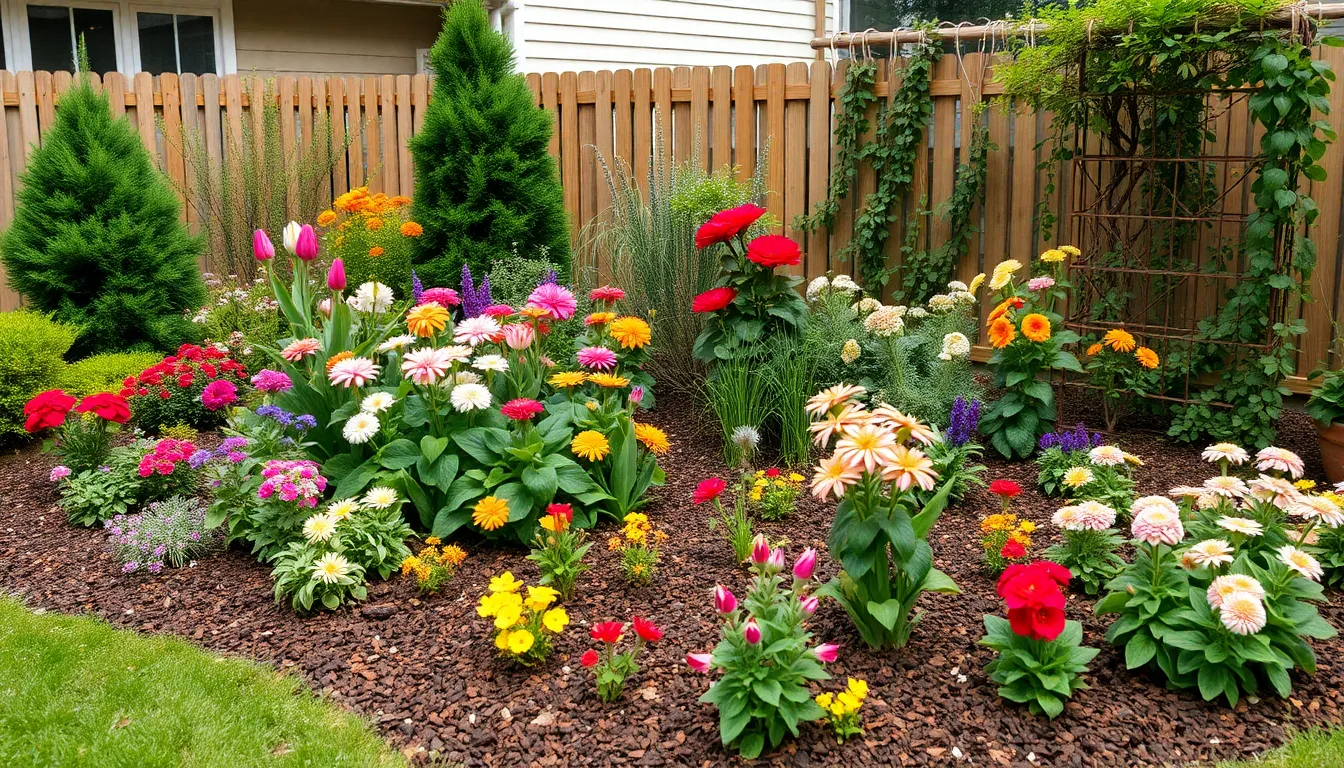
We can transform our small gardens into four-season showcases by choosing plants that adapt naturally to changing conditions throughout the year.
Year-Round Color Planning
Select a simple color palette of two to three dominant hues to maintain visual harmony and prevent our limited spaces from appearing cluttered. We recommend combining evergreen shrubs for constant structure with seasonal bloomers like spring bulbs, summer flowers, fall berries, and winter foliage.
Use climbing roses or wisteria on trellises for vertical color that doesn’t consume precious ground space. These vertical elements provide height and visual interest while maximizing our growing area.
Include perennials like lavender for consistent summer blooms that require minimal maintenance. We can pair these with hardy bulbs that emerge in early spring, followed by summer annuals and plants with stunning fall foliage.
Choose plants with colorful bark or persistent berries to maintain winter interest when most gardens look dormant. These elements ensure our small spaces remain attractive even during the coldest months.
Crop Rotation in Limited Space
Alternate plant families in containers or raised beds each season to prevent soil depletion and reduce pest buildup. We manage crop rotation by moving different plant types to new locations within our small garden layout.
Plant shallow-rooted crops like lettuce and radish after harvesting deep-rooted ones such as tomatoes and carrots. This strategy maximizes soil nutrients while giving different soil levels time to recover.
Use succession planting by sowing fast-maturing crops after early harvests to keep our productive spaces working continuously. We can plant new lettuce every two weeks or start bean seeds after radish harvest.
Consider intercropping by pairing fast-growing plants with slower ones to maximize space efficiency. Combining quick lettuce with slower tomatoes allows us to harvest the greens before the tomatoes need full space.
Weather Protection Strategies
Protect our gardens from adverse weather using cloches, row covers, or cold frames for early and late frost protection. These simple structures extend our growing seasons without requiring permanent installations.
Choose wind-resistant plant varieties in exposed areas to prevent damage during storms. We can select sturdy perennials and install evergreen climbers that serve as natural windbreaks while providing year-round protection.
Apply mulch to regulate soil temperature and moisture during extreme weather conditions. This simple technique protects plant roots from temperature fluctuations while conserving water.
Use shade cloth or erect temporary structures during heavy rains or intense sun exposure. Vertical gardens and wall planters naturally reduce ground exposure to harsh weather conditions, making them ideal for challenging climates.
| Weather Challenge | Protection Strategy | Best Plants |
|---|---|---|
| Frost | Cloches, row covers, cold frames | Hardy perennials, evergreens |
| Wind | Wind-resistant varieties, evergreen barriers | Ornamental grasses, sturdy shrubs |
| Extreme heat | Shade cloth, mulching | Heat-tolerant annuals, succulents |
| Heavy rain | Vertical gardens, proper drainage | Plants with good drainage needs |
Conclusion
Small gardens offer endless possibilities when we embrace creative answers and strategic planning. We’ve explored how vertical growing transforms walls into living art while container gardening brings flexibility to any space. Whether you’re working with a tiny balcony or a compact backyard these techniques help maximize every square inch.
The beauty of small gardens lies in their manageability and potential for year-round enjoyment. From budget-friendly DIY projects to multi-functional features we can create stunning outdoor sanctuaries that reflect our personal style. Remember that successful small gardens aren’t about having more space – they’re about making smart choices that deliver maximum impact.
Your small garden journey starts with a single plant or container. With these proven strategies you’re equipped to transform any compact area into a thriving green space that brings joy throughout the seasons.
Frequently Asked Questions
What makes small gardens easier to maintain than large ones?
Small gardens require less time, water, and resources to maintain. You can easily monitor plant health, manage watering schedules, and handle weeding in a compact space. The reduced scale makes tasks like pruning, fertilizing, and pest control more manageable, allowing you to focus on quality care rather than covering large areas.
How can I maximize growing space in a tiny garden?
Use vertical gardening techniques like trellises, wall-mounted planters, and hanging containers. Implement tiered planting systems with ladder planters or stacked containers. Choose multi-functional plants that serve both ornamental and edible purposes, and utilize every available space including corners, edges, and overhead areas.
What are the best plants for small garden spaces?
Select dwarf and compact varieties of your favorite plants, such as dwarf fruit trees and compact shrubs. Choose climbing plants for vertical growing, multi-purpose edible plants like herbs and berry bushes, and fast-growing options for quick results. These plants deliver full-sized beauty without overwhelming your limited space.
Can I create a productive garden on a balcony?
Absolutely! Use container gardening with pots, hanging planters, and window boxes. Install vertical wall gardens and utilize railings for climbing plants. Choose compact, productive varieties and herbs that thrive in containers. Focus on lightweight containers and ensure proper drainage for healthy plant growth.
How do I design a layout for a very small garden?
Try square foot gardening by dividing your space into organized 1-foot sections. Use circular or curved beds to create natural flow and make spaces feel larger. Maximize corners with triangular planting beds and trellises. Consider multi-functional features like benches with built-in planters to serve dual purposes.
What’s the most budget-friendly way to start a small garden?
Start with DIY projects using recycled materials like old containers and gutters. Begin with seeds instead of mature plants to save money. Share tools with neighbors or join community programs. Repurpose household items as unique planters and focus on fast-growing, productive plants for immediate satisfaction.
How can I garden indoors in small spaces?
Create kitchen counter herb gardens for fresh cooking ingredients. Use hydroponic systems for soil-free growing that maximizes space efficiency. Try succulent arrangements for low-maintenance beauty. Utilize windowsills, shelves, and hanging systems to create vertical growing areas without taking up floor space.
Which container gardening options work best for renters?
Choose portable containers like fabric grow bags and lightweight pots that can move with you. Use tabletop planters and hanging systems that don’t require permanent installation. Window boxes and mobile plant stands offer flexibility. Focus on plants that transplant easily and containers that fit standard moving boxes.
How do I maintain my small garden year-round?
Plan for seasonal color with evergreen shrubs and rotating seasonal bloomers. Implement crop rotation to maintain soil health. Use weather protection like frost covers and shade cloth. Choose plants that adapt well to changing conditions and maintain proper watering schedules adjusted for seasonal needs.
What are the biggest mistakes to avoid in small garden design?
Avoid overcrowding plants, which leads to poor growth and disease. Don’t choose plants that will outgrow your space quickly. Avoid neglecting vertical space opportunities and failing to plan for proper drainage. Don’t skip planning – random planting wastes precious space and creates maintenance challenges.


